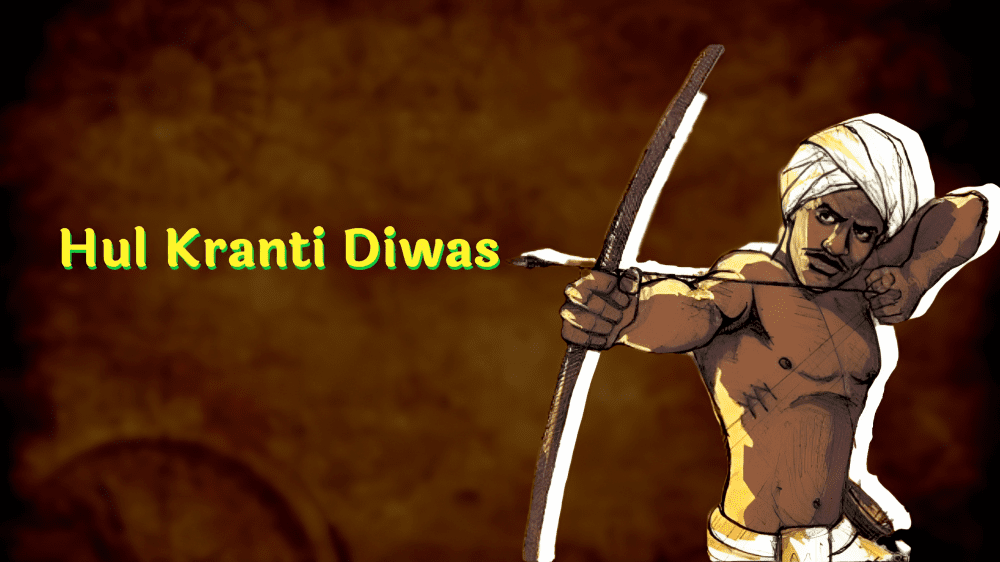Physical Address
304 North Cardinal St.
Dorchester Center, MA 02124
Physical Address
304 North Cardinal St.
Dorchester Center, MA 02124

Hul Kranti Diwas 30 June 1855
Hul Kranti Diwas 30 June 1855 is a very important date in the history of India, this day is also remembered as Hul Kranti Day. During this revolution, the Santhal tribal Sidhu gave the slogan “Do or Die, Britishers leave our soil”. Do or Die you all must have heard this slogan. Whose name comes to your mind when you hear this slogan? Of course, Mohandas Karamchand Gandhi. In 1942, the All India Congress Committee in today’s Mumbai passed the resolution of the Quit India Movement, on the same day Gandhiji gave the slogan “Do or Die”.
But was this slogan really given by Gandhiji? If you try to understand history objectively, then you will come to know that the slogan “Do or Die” is the gift of the tribals of this country. It is the slogan which has its broader contribution from the indigenous people of this country in the fight for freedom. Generally not the kind of information found in the mainstream knowledge domain. So much soil was poured on the sacrifice of those 20000 tribals, Dalits and others that we could not even find their skeletons.

Story Of 20000 martyr of Adivasi
The period was the year 1800, our country was under British rule. The atrocities of British rule were not only in the towns and villages, they had started their intrusion into the forests as well. The natives of this country living in the jungles, who loved nature for thousands of years, made it their home and took care of the forests. The tribals saved the forests and the jungles saved the tribals. The tribals considered the forest the land and the water as their everything. Even today, tribals give more importance to the forest than their lives. On the one hand, the tribal society was already troubled by moneylenders, on the other hand, the British government was trying to make the tribals run away from the jungle. The tyranny of the British rulers reached its peak when the Britishers imposed Malguzari to collect revenue from the Santhal Adivasi and other residents. Now there was double exploitation of Santhal tribals and other tribes as well. Because of this, the fire of discontent and rebellion started smouldering among the people here.
Whenever there is dissatisfaction and rebellion in society, someone has to come forward to give the right direction to that rebellion. To turn this discontent into a mass movement to provide direction to the rebellion of Santhal tribals and other residents of that area, the heroes of this mass movement, the landless residents of Bhagnadih, the four sons of village head Chunni Mandi, Sidhu, Kanhu, Chand and Bhairav would come forward. To widen his rebellion, he declared war in the surrounding neighbourhoods and 400 villages by making dugdugi, people started travelling from village to village with a branch of the Sal tree in their hand. The day came 30 June 1955, to finalize their movement, the tribals took their traditional weapons and started reaching Bhagnadih. Historians write that on 30 June 1855, about 50,000 people from more than 400 villages reached Bhagnadih. This was the beginning of his war, Karl Marx mentioned in his book Notes of Indian History called this war “Santhal Hul” an armed revolution. In this meeting, all four brothers Sidhu, Kanhu, Chand and Bhairav announced that they would not give Malguzari. After this, the British government ordered the arrest of these four brothers. But the policeman who had been sent to arrest these four brothers, the Santhali killed him by beheading him. This incident created fear in the administration.
The British government somehow wanted to extinguish the fire of this revolution, then for this, they should use water or blood, they had no concern with this matter. The same thing happened, Bhagalpur was converted into an army cantonment, and the British government sent the army to the area. The series of arrests started, and the revolutionaries refused to accept Defeat. Thousands of people got martyrdom in the flames of this revolution. Historians believe that 20,000 people got martyrdom in this freedom war. During this struggle, Chand and Bhairav were martyred in Bahraich. Although British rule was capable from the beginning, they had trained soldiers, modern weapons and resources. Yet, for winning this war, the British government rewarded the revolutionaries with their heads. Both Kranti veers Sindhu and Kanhu’s brothers were given a reward of 10000 on their heads, in the greed of this, a trustworthy partner betrayed both the brothers. Sindhu and Kanhu were arrested and on 26 July 1955, both the brothers were hanged from a tree in the village. In this way, four brothers got their names recorded in golden letters in Indian history. Since then, 30 June 1955 has been celebrated as Hul Kranti Diwas. This whole revolution continues even today, the tribal society in the whole of India is fighting for its water, land and forest, the only difference is that this time there is no outsider but a resident of India.

Sindhu Kanhu
It is a matter of great sadness that such revolutionaries were deliberately omitted from the history of India in a very well-thought-out manner. Those who really laid the foundation of revolution in this country were forgotten. Mangal Pandya was remembered and included in the curriculum, but the heroes like Tilak Manjhi Sindhu Kanhu Chand Bhairav were buried in the ground so that the coming generation would sacrifice their lives. One could never know its bravery.
Article Written by Rajat Mourya, Edited By Shilpi Kishore